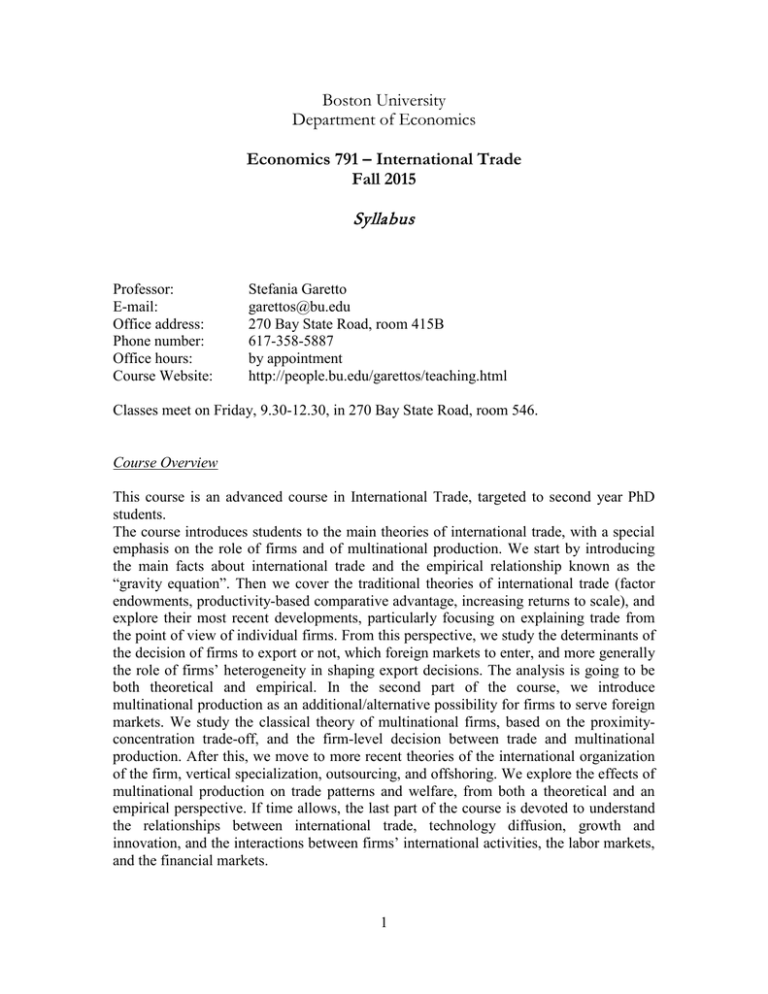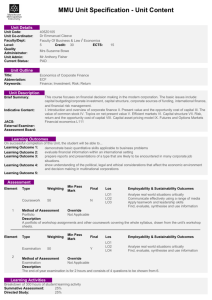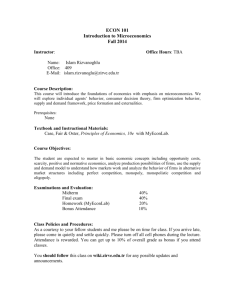Syllabus Boston University Department of Economics
advertisement

Boston University Department of Economics Economics 791 – International Trade Fall 2015 Syllabus Professor: E-mail: Office address: Phone number: Office hours: Course Website: Stefania Garetto garettos@bu.edu 270 Bay State Road, room 415B 617-358-5887 by appointment http://people.bu.edu/garettos/teaching.html Classes meet on Friday, 9.30-12.30, in 270 Bay State Road, room 546. Course Overview This course is an advanced course in International Trade, targeted to second year PhD students. The course introduces students to the main theories of international trade, with a special emphasis on the role of firms and of multinational production. We start by introducing the main facts about international trade and the empirical relationship known as the “gravity equation”. Then we cover the traditional theories of international trade (factor endowments, productivity-based comparative advantage, increasing returns to scale), and explore their most recent developments, particularly focusing on explaining trade from the point of view of individual firms. From this perspective, we study the determinants of the decision of firms to export or not, which foreign markets to enter, and more generally the role of firms’ heterogeneity in shaping export decisions. The analysis is going to be both theoretical and empirical. In the second part of the course, we introduce multinational production as an additional/alternative possibility for firms to serve foreign markets. We study the classical theory of multinational firms, based on the proximityconcentration trade-off, and the firm-level decision between trade and multinational production. After this, we move to more recent theories of the international organization of the firm, vertical specialization, outsourcing, and offshoring. We explore the effects of multinational production on trade patterns and welfare, from both a theoretical and an empirical perspective. If time allows, the last part of the course is devoted to understand the relationships between international trade, technology diffusion, growth and innovation, and the interactions between firms’ international activities, the labor markets, and the financial markets. 1 Grading A second-year topic class should introduce students to independent research, and facilitate the transition from coursework to writing a PhD Thesis. For this reason, the course grade is based on three separate components: • A referee report of a paper of your interest, not necessarily among the ones in the syllabus, to be decided with me in advance (20% of the grade). • A 30-minutes presentation of a paper of your interest, not necessarily among the ones in the syllabus, to be decided with me in advance (30% of the grade). • An individual research project, to be discussed with me by October 31st, and to be handed in by Friday, December 18th (50% of the grade). All assignments must be completed individually, and late assignments will not be accepted. Academic Conduct It is your responsibility to know and understand the provisions of the CAS Academic Conduct Code (copies are available in room CAS 105). Cases of suspected academic misconduct will be referred to the Dean's Office. Reading list There is no required textbook for this course. However, I will sometimes draw from the following: - Feenstra, R. (2004). Advanced International Trade: Theory and Evidence. Princeton University Press. [Henceforth, F] - Helpman, H., and P. Krugman (1995). Market Structure and Foreign Trade. Cambridge, MIT Press. [Henceforth, HK] 2 Course Outline (Tentative: may be subject to changes) Items marked with (**) are essential and will be covered extensively in class. Items market with (*) are required readings. I will briefly talk about them in class, but you are required to go through them on your own. The remaining items are suggested readings, which you should be familiar with if you plan to do research in this area. Finally, items marked with (R) are papers that review a particular aspect of the field. These papers are particularly useful to frame the discussion in class and to start research projects on a topic. I. Trade patterns and the gravity equation (Sept. 4th) (R) Helpman, H (1999). “The Structure of Foreign Trade”. Journal of Economic Perspectives 13(2): 121-144. (**) F, Chapter 5, pp.144-173. (*) McCallum, J. (1995). “National Borders Matter: Canada-US Regional Trade Patterns”. The American Economic Review 85(3): 615-623. (*) Anderson, J., and E. van Wincoop (2003). “Gravity with Gravitas: A Solution to the Border Puzzle”. The American Economic Review 93(1): 170-192. Anderson, J., and E. van Wincoop (2004). “Trade Costs”. Journal of Economic Literature 42(3): 691-751. Disdier, A.C., and K. Head (2008), "The Puzzling Persistence of the Distance Effect on Bilateral Trade", Review of Economics and Statistics 90(1): 37-48. II. Trade Theories 1. Factor endowments: the Heckscher-Ohlin model (Sept. 11th) (**) F, Chapters 1-3. HK, Chapters 1-2. Jones, R. (1965). “The Structure of Simple General Equilibrium Models”. Journal of Political Economy 73(6): 557-572. Helpman, H. (1984). “The Factor Content of Foreign Trade”. Economic Journal 94: 8494. 3 Trefler, D. (1995). “The Case of the Missing Trade and Other Mysteries”. The American Economic Review 85(5): 1029-1046. 2. Comparative advantage: Ricardian Trade Theory (Sept. 18th- Oct.9th) F, Chapter 1. (**) Dornbusch, R., S. Fischer, and P. Samuelson (1977). “Comparative Advantage, Trade, and Payments in a Ricardian Model with a Continuum of Goods”. The American Economic Review 67(5): 823-839. (**) Eaton, J., and S. Kortum (2002). “Technology, Geography and Trade.” Econometrica 70(5): 1741-1779. (*) Alvarez, F., and R.E. Lucas, Jr. (2007). “General Equilibrium Analysis of the EatonKortum Model of International Trade”. Journal of Monetary Economics 54 (6): 17261768. Costinot, Arnaud (2009). “An Elementary Theory of Comparative Advantage”. Econometrica 77(4): 1165-1192. Costinot, A., D. Donaldson, and I. Komunjer (2012). “What Goods Do Countries Trade? A Quantitative Exploration of Ricardo's Ideas”. Review of Economic Studies 79(2): 581608. (*) Bernard, A.B., J. Eaton, J.B. Jensen, and S. Kortum (2003). “Plants and Productivity in International Trade”. The American Economic Review 93(4): 1268-1290. 3. Monopolistic Competition and Increasing Returns a) With Homogeneous Firms (Oct. 9th) (**) Krugman, P. (1979). “Increasing Returns, Monopolistic Competition, and International Trade”. Journal of International Economics 9(4): 469-479. (**) Krugman, P. (1980). “Scale Economies, Product Differentiation and the Pattern of Trade”. The American Economic Review 70(5): 950-959. Dixit, A., and J. Stiglitz (1977). “Monopolistic Competition and Optimum Product Diversity”. The American Economic Review 67(3): 297-308. F, Chapter 5. HK, Chapters 6-9. 4 b) With Heterogeneous Firms (Oct. 16th-23rd) (*) Melitz, M. J. (2008). “International Trade and Heterogeneous Firms”. The New Palgrave Dictionary of Economics. 2nd Edition. Eds. Steven N. Durlauf and Lawrence E. Blume. Palgrave Macmillan. (**) Melitz, M. J. (2003). “The Impact of Trade on Intra-Industry Reallocations and Aggregate Industry Productivity”. Econometrica 71(6): 1695-1725. (*) Melitz, M. J., and G.I.P. Ottaviano (2008). “Market Size, Trade, and Productivity”. Review of Economic Studies 75 (1): 295–316. Chaney, T. (2008). “Distorted Gravity: the Intensive and Extensive Margins of International Trade”. The American Economic Review 98(4): 1707-1721. Arkolakis, C. (2010). “Market Penetration Costs and the New Consumers Margin in International Trade”. Journal of Political Economy 118 (6): 1151-1199. 4. Gains from Trade (Oct. 30th) (*) Arkolakis, C., P. Klenow, S. Demidova and A. Rodriguez-Clare (2008). “Endogenous Variety and the Gains from Trade”. American Economic Review Papers and Proceedings 98 (4): 444- 450. (*) Arkolakis, C., A. Costinot, and A. Rodriguez-Clare (2012). “New Trade Models, Same Old Gains?”. The American Economic Review 102(1):94-130. Arkolakis, C., A. Costinot, D. Donaldson, and A. Rodriguez-Clare (2015). “The Elusive Pro-Competitive Effects of Trade”. Mimeo. III. Empirical Evidence 1. The Extensive Margin of Trade (Oct. 30th) (**) Eaton, J., S. Kortum, and F. Kramarz (2011). “An Anatomy of International Trade: Evidence from French Firms”. Econometrica 79(5): 1453-1498. (**) Helpman, E., M.J. Melitz, and Y. Rubinstein (2008). “Trading Partners and Trading Volumes”. Quarterly Journal of Economics 123(2): 441-487. Broda, C., and D.Weinstein (2006). ”Globalization and the Gains from Variety”. Quarterly Journal of Economics 121(2): 541-585. 5 2. Firm-level Productivity (Nov. 6th) (*) Bernard, A.B., J.B. Jensen S. Redding, and P.K. Schott (2007). “Firms in International Trade”. Journal of Economic Perspectives 21(3): 105-130. (*) Bernard, A.B. and J.B. Jensen (1999). “Exceptional Exporter Performance: Cause, Effect, or Both?”. Journal of International Economics 47(1): 1-25. Bernard, A., and J.B. Jensen (2004). “Why Some Firms Export”. The Review of Economics and Statistics, 86(2): 561-569. Bernard, A.B., J.B. Jensen S. Redding, and P.K. Schott (2006). “Trade Costs, Firms and Productivity”. Journal of Monetary Economics 53(5): 917-937. Tybout, J. (2005). “Plant- and Firm-level Evidence on the 'New' Trade Theories”. In E.K. Choi and J.Harrigan, eds., Handbook of International Trade. Oxford: Basil-Blackwell. (**) Roberts, M., and J. Tybout (1997). “The Decision to Export in Colombia: An Empirical Model of Entry with Sunk Costs”. The American Economic Review, 87(4): 545-565. Das, S., M. Roberts, and J. Tybout (2007). “Market Entry Costs, Producer Heterogeneity and Export Dynamics”. Econometrica 75(3): 837-873. (*) Pavcnik, N. (2002). “Trade Liberalization, Exit, and Productivity Improvements: Evidence from Chilean Plants”. The Review of Economic Studies 69(1): 245-76. IV. Multinational production. 1. Introduction and classical theory (Nov 6th) (**) Bernard, A.B., J.B. Jensen, and P.K. Schott (2009). “Importers, Exporters, and Multinationals: A Portrait of Firms in the U.S. that Trade Goods”. In T. Dunne, J.B. Jensen and M.J. Roberts (eds.), Producer Dynamics: New Evidence from Micro Data. Chicago: University of Chicago Press. (R) Helpman, E. (2006). “Trade, FDI, and the Organization of Firms”. Journal of Economic Literature 44(3): 589-630. (**) Helpman, E. (1984). “A Simple Theory of International Trade and Multinational Corporations”. Journal of Political Economy 92(3): 451-471. 6 Helpman, E. (1985). “Multinational Corporations and Trade Structure”. Review of Economic Studies 52(3): 443-457. HK, Chapters 12-13. 2. The proximity-concentration trade-off (Nov. 13th) (*) Markusen, J. R. (1984). “Multinationals, Multi-Plant Economies, and the Gains from Trade”. Journal of International Economics, 16: 205-226. Markusen, J.R. (1995). “The Boundaries of Multinational Enterprises and the Theory of International Trade”. Journal of Economic Perspectives, 9(2): 169-189. (*) Brainard, S.L. (1997). “An Empirical Assessment of the Proximity-Concentration Trade-off between Multinational Sales and Trade”. The American Economic Review 87(4): 520-544. (**) Helpman, E., M.J. Melitz, and S.R.Yeaple (2004). “Exports versus FDI with Heterogeneous Firms”. The American Economic Review 94(1): 300-316. 3. Vertical Specialization (Nov 13th) (**) Yi, K. (2003) Can Vertical Specialization Explain the Growth of World Trade? Journal of Political Economy 111(1): 52-102. Hummels, D., J. Ishii, and K. Yi (2001). “The Nature and Growth of Vertical Specialization in World Trade.” Journal of International Economics 54(1): 75-96. Johnson, R.C., and G. Noguera (2012). “Accounting for Intermediates: Production Sharing and Trade in Value Added”. Journal of International Economics 86(2): 224-236. (*) Hanson, G.H., R.J. Mataloni, and M.J. Slaughter (2005). “Vertical Production Networks in Multinational Firms.” The Review of Economics and Statistics 87 (4): 664678. Costinot, A., J. Vogel and S. Wang (2013). “An Elementary Theory of Global Supply Chains”. Review of Economic Studies 80: 109-144. 4. Firm Organization and Trade (Nov. 20th) (R) Antràs, P., and E. Rossi-Hansberg (2009). “Organizations and Trade”. Annual Review of Economics 1: 43-64. 7 (**) Antràs, P. (2003). “Firms, Contracts, and Trade Structure”. Quarterly Journal of Economics, 118 (4): 1375-1418. (**) Antràs, P., and E. Helpman (2004). “Global Sourcing”. Journal of Political Economy 112(3): 552-580. (*) Grossman, G.M. and E. Helpman. (2002). “Integration vs. Outsourcing in Industry Equilibrium”, Quarterly Journal of Economics 117 (1): 85-120. (*) Grossman, G.M., and E. Helpman. (2005). “Outsourcing in a Global Economy”. Review of Economic Studies, 72(1): 135-159. Grossman, S.J., and O.D. Hart (1986). “The Costs and Benefits of Ownership: A Theory of Vertical and Lateral Integration”. Journal of Political Economy 94(4): 691-719. (*) Antràs, P., L. Garicano, and E. Rossi-Hansberg (2006). “Offshoring in a Knowledge Economy”. Quarterly Journal of Economics 121(1): 31-77. Caliendo, L., and E. Rossi-Hansberg (2012). “The Impact of Trade on Organization and Productivity”. Quarterly Journal of Economics 127(3): 1393-1467. 5. Offshoring and Outsourcing (Dec 4th) Amiti, M. and S. Wei (2009). “Service Offshoring and Productivity: Evidence from the US”. The World Economy 32(2): 203-220. (**) Grossman, G., and E. Rossi-Hansberg (2008). “Trading Tasks: A Simple Theory of Offshoring”. The American Economic Review 98(5): 1978-1997. (*) Garetto, S. (2013) “Input Sourcing and Multinational Production”. Economic Journal: Macroeconomics 5(2): 118-151. American Rodriguez-Clare, A. (2010) “Offshoring in a Ricardian World”. American Economic Journal: Macroeconomics, 2(2): 227-58. V. Other topics (if time allows). 1. Trade, Innovation and Growth (*) Eaton, J., and S. Kortum (1999). “International Technology Diffusion: Theory and Measurement”. International Economic Review 40(3): 537-570. (*) Eaton, J., and S. Kortum (2001). “Technology, Trade, and Growth: A Unified Framework”. European Economic Review 45: 742-755. 8 Kortum, S. (1997). “Research, Patenting, and Technological Change”. Econometrica 65(6): 1389-1419. (*) Rodriguez-Clare, A., and N. Ramondo (2013). “Trade, Multinational Production, and the Gains from Openness”. Journal of Political Economy 121(2). 2. Trade and the Labor Markets (**) Helpman, E., O. Itskhoki, and S. Redding (2010). “Inequality and Unemployment in a Global Economy”. Econometrica 78 (4): 1239–1283. Fajgelbaum, P.D. (2013). “Labor Market Frictions, Firm Growth and International Trade”. Mimeo. Feenstra, R., and G. Hanson (1999). “The Impact of Outsourcing and High Technology Capital on Wages: Estimates for the United States, 1970-1990”. Quarterly Journal of Economics 114(3): 907-940. (R) Feenstra, R., and G. Hanson (2001). “Global Production Sharing and Rising Inequality: A Survey of Trade and Wages”. In E.K. Choi and J.Harrigan, eds., Handbook of International Trade. Oxford: Basil-Blackwell. 3. Trade and Asset Pricing (**) Fillat, J.L., and S. Garetto (2015). “Risk, Returns, and Multinational Production”. Quarterly Journal of Economics, Forthcoming. Fillat, J.L., S. Garetto, and L. Oldenski (2015). Diversification, Cost Structure, and the Risk Premium of Multinational Corporations. Journal of International Economics 96(1): 37-54. 4. Trade and Multi-Product Firms (**) Bernard, A. B., S. Redding, and P. K. Schott (2010). “Multi-product Firms and Product Switching”. The American Economic Review 100(1): 70-97. (**) Mayer, T., M.J. Melitz, and G.I.P. Ottaviano (2014). “Market size, Competition, and the Product Mix of Exporters”. The American Economic Review 104(2):495-536. Bernard, A.B., S.J. Redding and P.K. Schott (2011). “Multi-Product Firms and Trade Liberalization”. Quarterly Journal of Economics 126(3):1271-1318. 9





